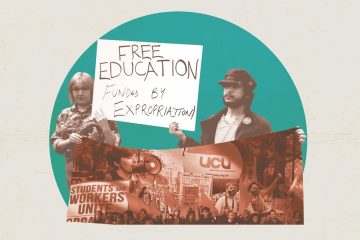After weeks of organizing, a rapidly growing fee strike movement at SOAS succeeded in forcing the university administration to sit down with a committee of student organizers on 19th February to negotiate a set of impressive demands that includes an unconditional tuition refund for students.
Bringing the intransigent administration of new SOAS Director Adam Habib to the negotiation table was itself a minor victory for the student campaign, which calls itself SOASWTFees. Although student organizers first invited the administration to a discussion on 3rd February in a communication articulating the campaign’s demands, it took weeks for the university to take these mobilizations seriously.
Before even replying to the letter, on 8th February the Director of Student and Academic Support sent out a condescending email titled “How Can I Help?” to the entire student body, assuring that “it can be frustrating … if emails go unanswered or you can’t find the information you need to support you” and that therefore the university would launch “a new email address for when you have tried to pursue things as much as you can, but are still not getting the information you need” — howcanihelp@soas.ac.uk.
It was only after students engaged in a tuition strike on the 14th February payment deadline — cutting off the university from its “income flow” — that the administration was moved to action. Yet the administration only continues to buy time through half-measures, scrambling to pacify students with minor reforms that cost no money, like deadline extensions or grading scheme adjustments.
In fact, two weeks after the payment deadline, the administration has not yet acknowledged the strike itself. It has not even issued the warning usually sent to students who have not paid their fees. But the administration’s momentarily cautious stance must be understood in view of the fact that non-payment of fees is not only due to the strike action, but to the administration’s own incompetence. Many students who require an invoice to transfer the money have been waiting for months for the university to merely issue the document. Other students intended to pay through external loans, but found the fees office dragging its feet to complete its end of the paperwork. How can the administration retaliate against a fee strike when it does not even have the institutional capacity to collect tuition fees to begin with?
How We Got in This Mess
Unfortunately, this starkly paradoxical situation is representative of the incompetence that led the university to its current crisis, as years of financial mismanagement and the marketisation of higher education thrust SOAS over the cliff of bankruptcy on the eve of the COVID-19 crisis.
In this financial free-fall, an administrative shake-up sought to eject as much “dead weight” as it could, all the while gliding to safety on a parachute of student debt and austerity. Led by Adam Habib, the restructuring has resulted in major staff cuts, casualization and the overworking of remaining staff. And that was before the pandemic.
Despite the challenges of the ongoing crisis, in 2020 the administration was not dissuaded from enthusiastically enrolling a full cohort of new students attracted by empty promises of “blended learning” with robust student support. In reality, students today have virtually no access to essential facilities or support of any kind. Although the SOAS Library is technically open for students who reside in London at the moment, it is a blatant lie for the administration to now argue that “blended learning” never meant anything more than this.
Crucially, many key courses at SOAS have been completely ravaged. Some graduate students came to the university to discover that the supervisors with whom they had intended to work had been dismissed altogether. Students in the Music Department — which is rated first in the entire United Kingdom — are stuck with no access to rehearsal facilities or even instruments. Additionally, students originally enrolled in various different Area Studies courses were tossed into the more generic Near & Middle Eastern Studies course — likewise rated first in the country — and promised they could take the same modules. But in the case of Iranian Studies most notably, virtually all the relevant courses were dropped, forcing students to complete their degrees without hardly engaging the subject at all.
Adam Habib is getting credit for having brought back the university from the brink. On the contrary, he has hollowed out the university’s core courses, cutting academic staff and limiting key resources for the sake of the holy profit margin — pushing SOAS to the verge of self-destruction.
The Demand for Free Education
As the accumulation of student grievances organically swelled in the few online spaces where students can interact, an enthusiastic mass came into conversation discussing how to make the administration resolve these concerns.
At first, some students voiced their desire to see financial compensation, seeing as the university had failed to deliver on the “product” it had advertised. However, early interventions, including by members of the SOAS Marxist Society — with the crucial help of a sympathetic Student Union — encouraged the campaign to reject the market logics that treat education as a commodity and the student as a consumer, connecting these to the university’s ruinously hollowed-out state. In the final list of demands, then, the call for free education was resolutely included.
Inspired by the bold call for free education, over one thousand students co-signed the campaign’s letter to the administration, while over one hundred students are committed to the ongoing strike. Such enthusiasm is simply unprecedented, especially in a moment when most students have never met in person, organising efforts are bogged down by “Zoom fatigue” and lockdown conditions worsen mental health among us all.
Conclusion
Enthusiasm is only building among students, who are gripping the administration tighter as they feel it trying to wriggle its way out of accountability. Students are seeing that militancy pays off — all the more when grievances are articulated through a coherent, radical political vision. But steadfastness and firm commitment to the campaign’s ideals are required to swat away the administration’s concessions and half-measures that fail to meet the demands.
Ultimately, students must remember that strength is a factor of unity, as the university’s very economic solvency — tuition fees — are quite literally in their hands. We must also remember that SOAS is a single point of a wholly rotten system, which is why the SOAS Marxist Society stresses the importance of linking up with similar movements at other universities. Students across the country must strike in unison, broadening the struggle to the widest possible arena — including university workers, academic staff and faculty, who are just as victimized by the marketisation of education.
Read below the statement on the tuition strike from the SOAS Marxist Society, stressing the student campaign’s four key demands:

By Rafiq Abdul-Bahá, SOAS Marxist Society




0 Comments